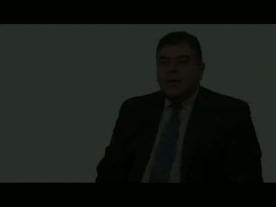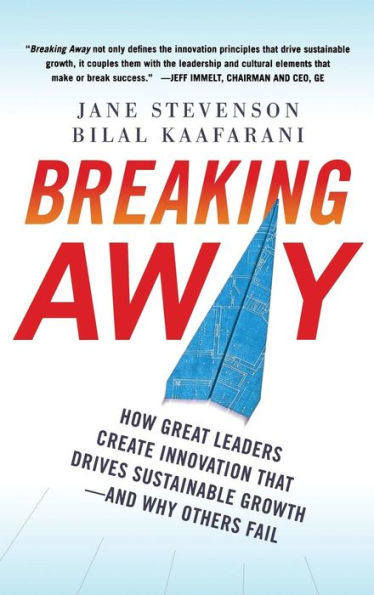Breaking Away: How Great Leaders Create Innovation that Drives Sustainable Growth--and Why Others Fail / Edition 1 available in Hardcover

Breaking Away: How Great Leaders Create Innovation that Drives Sustainable Growth--and Why Others Fail / Edition 1
- ISBN-10:
- 007175394X
- ISBN-13:
- 9780071753944
- Pub. Date:
- 02/22/2011
- Publisher:
- McGraw Hill LLC
- ISBN-10:
- 007175394X
- ISBN-13:
- 9780071753944
- Pub. Date:
- 02/22/2011
- Publisher:
- McGraw Hill LLC

Breaking Away: How Great Leaders Create Innovation that Drives Sustainable Growth--and Why Others Fail / Edition 1
Hardcover
Buy New
$43.00Buy Used
$29.99-
-
SHIP THIS ITEM
Temporarily Out of Stock Online
Please check back later for updated availability.
-
Overview
The blueprint for achieving growth and driving shareholder value by embedding support for innovation into every facet of your business
Breaking Away is one of the first books to bridge the gap between leadership and innovation by revealing what it takes to create both breakthrough ideas and the leaders who make them happen.Written by the chief innovation officer for Coca-Cola and a leading recruiter of innovation leaders, Breaking Away provides a framework that executives, managers, and entrepreneurs can use to create an environment that drives REAL innovation, the breakthrough products or services that are: efficient to produce or deliver; in demand; and profitable.
Interviews and case studies of global giants like Burberry, Mastercard, Nestle, GE, HP, Nintendo, and others, show you how leaders put these principles into action: How Ford beat Toyota to the hybrid (and why everyone thinks the Japanese company got there first); how GE is changing the face of cancer treatment; how a self-confessed “snackaholic” drove Lesser Evil Snacks to 120% Y-o-Y growth-and a place among the INC. 500 “fastest growing companies” index.

Product Details
| ISBN-13: | 9780071753944 |
|---|---|
| Publisher: | McGraw Hill LLC |
| Publication date: | 02/22/2011 |
| Pages: | 304 |
| Product dimensions: | 6.20(w) x 9.10(h) x 1.00(d) |
| Age Range: | 18 Years |
About the Author
Jane Edison Stevenson is Vice Chairman, Board and CEO Services at Korn/Ferry International, the world’s leading C-suite talent management firm, and has spent 25 years assessing and recruiting the world’s top innovation leaders.
Bilal Kaafarani is Senior VP, Global Research and Innovation officer of The Coca-Cola Company. He has held leadership roles with Frito Lay Tropicana, Proctor & Gamble, and Kraft, where he developed the technology resulting in the successful “Kraft Free” products. He holds several patents for breakthrough technologies in the food sector.
Read an Excerpt
BREAKING AWAY
HOW GREAT LEADERS CREATE INNOVATION THAT DRIVES SUSTAINABLE GROWTHâ?"AND WHY OTHERS FAIL
By JANE STEVENSON, BILAL KAAFARANI
The McGraw-Hill Companies, Inc.
Copyright © 2011Jane Stevenson and Bilal KaafaraniAll rights reserved.
ISBN: 978-0-07-175394-4
Excerpt
CHAPTER 1This Is Innovation
A Rose by Any Other Name
"Never before in history has innovation offered promise of so much to so many in so short a time."
—BILL GATES
The year was 1752. Dark clouds filled the sky while a father and son walked across an isolated field toward a small shed. No one knew they were there or what they hoped to accomplish. If they succeeded, there would be time for that; if they failed, no one would be the wiser. As storm clouds gathered, the father launched his contraption—a kite with a string made of twine and an iron key attached to it by a length of nonconducting silk. Wrapping the silk around his hand, he watched the kite rise into the sky and waited.
One promising cloud after another passed. Just as they were about to give up, the father noticed some loose threads from the twine standing straight out like the excited hairs on the back of one's neck when something is about to happen. Curious, he moved his knuckles toward the dangling key, and an electric spark appeared. As rain soaked the cord, more sparks flew, and for the first time, Benjamin Franklin saw what he would later dub "electric fire."
Many have heard this story of Franklin and his famous kite. What most don't realize, however, is that he wasn't the first to prove the theory that electricity and lightning are one and the same. Unknown to him, French naturalist Thomas-François Dalibard, inspired by Franklin's writings, had beaten him to the punch a month before. Within weeks of hearing the news, others throughout Europe repeated the same experiment. So why is Franklin remembered as the father of electricity, while the others are little more than a footnote? It's simple: unless discovery is followed by invention and innovation, even something as profound as electricity means little to the ordinary person. The reason we remember Ben Franklin is because, in addition to his discovery, he and others after him did something with it, and from these inventions came innovations that changed our world.
In this chapter, we'll begin to create a universal context for innovation—what distinguishes it from discovery and invention, what defines it, and what the key components are. We'll also look at the sequence for innovation, which starts with curiosity like Franklin's and evolves through experimentation, utilization, and adoption or social change. Finally, we'll reveal the real treasure—a model for innovation so simple and elegant in concept that it will change the way innovation is defined and how it's talked about in boardrooms, C-suites, and classrooms around the world. Along the way, we'll learn from some of history's greatest innovators and from leaders and companies who have mastered unique types of innovation in modern times. Their stories will help illustrate the workings of innovation and how you can harness it to change your own company in unimagined ways.
Discovery, Invention, and Innovation
One of the traps many people fall into when thinking about innovation is using the term interchangeably with its more celebrated cousins—discovery and invention. While all three share elements of "newness," they are essentially different branches of the same family tree. Understanding the difference between them is the first step toward simplifying innovation.
At the root is discovery. Driven by curiosity, human need, and insight, discovery uncovers something previously unknown or unrecognized. It's not just new; it's unimagined by all but the curious few. Franklin's discovery was exciting, but in truth, it was at first of little use to the general public. To make his discovery useful, it had to progress to invention.
Invention happens when something that is known—such as an idea about electricity—is turned into something new through experimentation. Franklin used his discovery to invent the first commercial application of electricity, the lightning rod. From there, others added their own insights to advance electricity and inspire a young Thomas Edison, who, more than a hundred years later, literally lit up the world.
Edison is often credited with "inventing" the light bulb, but the truth is no one person can claim that accomplishment. What Edison did was improve on a primitive, fifty-year-old light fixture by combining new materials and systems, thus creating the first practical incandescent light bulb. This achievement didn't happen overnight. In fact, it took years, a team of scientists, and more than nine hundred experiments that didn't work before finding the one that did.
In December 1879, Edison held the first public demonstration of his long-lasting light bulb in Menlo Park, New Jersey, where perhaps his most significant and least-known accomplishment was born: the world's first industrial research laboratory. Set up specifically to produce constant technological innovation and improvement, it was home to an elite staff of engineers and researchers who, under Edison's direction, worked on the telephone, the phonograph, the electric railroad, and of course, the electric light bulb. By 1880, the facility was developing commercial electrical lighting components. Soon after, Edison opened his first factory to build the products conceived at Menlo Park. This was the beginning of the commercialization of the electric industry and the company we know today as General Electric.
This sequence—where discovery uncovers, invention creates, and innovation expands the idea into something customers want to buy—has been consistently repeated throughout history. Edison's genius was his ability to recognize this sequence and put it to work on a large scale. Throughout his life, he took on the task of "bringing good things to life" in a big way. Because he did, society changed, and the world was transformed.
Illumination, automobiles, telephones, and the Internet may all have been made possible because of invention, but they were made available through innovation. None of them would have existed without the harnessing of electricity. Can you trace your company's products and services back to Edison? Can you see the footprint of other great discoveries like the wheel, stone tools, or even cave paintings in your company's DNA? If you're an executive with John Deere, Home Depot, or Facebook, you'll find your history in these long-ago discoveries. Following the threads of your origins gives you a perspective you probably didn't have before. Recognizing the roots of innovation is the first step to seeing it all around you.
The Nature of Innovation
Virtually every business leader today would agree that understanding and mastering innovation is one of the most important challenges companies face. Innovation has been the subject of debate, discussion, study, and more than a few arguments over the past hundred years. So when we began to talk about innovation with business leaders, it wasn't surprising that no two thought about it in the same way.
Cammie Dunaway, executive vice president of marketing and sales for Nintendo Americas, describes it as "the point where consumer insight, market opportunity, and development of a product or service intersect." Ajay Banga, president and CEO of MasterCard, defines it as "an idea that is inherently scalable. If you can't scale it, it's not really innovation." Bill Ford, executive chairman of Ford Motor Company, simply says that innovation comprises "products and processes that make people's lives better."
None of these answers are right or wrong; they are just different. It's this difference in thinking about what innovation is that makes talking about it, maximizing it,
(Continues...)
Excerpted from BREAKING AWAY by JANE STEVENSON. Copyright © 2011 by Jane Stevenson and Bilal Kaafarani. Excerpted by permission of The McGraw-Hill Companies, Inc..
All rights reserved. No part of this excerpt may be reproduced or reprinted without permission in writing from the publisher.
Excerpts are provided by Dial-A-Book Inc. solely for the personal use of visitors to this web site.
Table of Contents
PART ONE: THE INNOVATION EQUATION; Chapter 1. A Rose by Any Other Name: This is Innovation; Chapter 2. Let There Be Light: Finding Inspiration; Chapter 3. The Sweet Spota: Innovation that Performs; PART TWO: THE LEADERSHIP EQUATION; Chapter 4. Mirror, Mirror on the Wall: The Role of Leadership in Innovation; Chapter 5. The Right Stuff: Leadership Personalities; Chapter 6. One for All and All for One: Creating an Innovation Culture; Chapter 7. The Buck Stops Here: The CEO Factor; PART THREE: THE PAYOFF; Chapter 8. It's a Jungle in Here: Creating an Innovation Environment; Chapter 9. A Company of Ones: The People Component; Chapter 10. Here's the Beef: Engaging the Market; Chapter 11. Are You Ready?: Taking up the GauntletRelated Subjects
Videos


